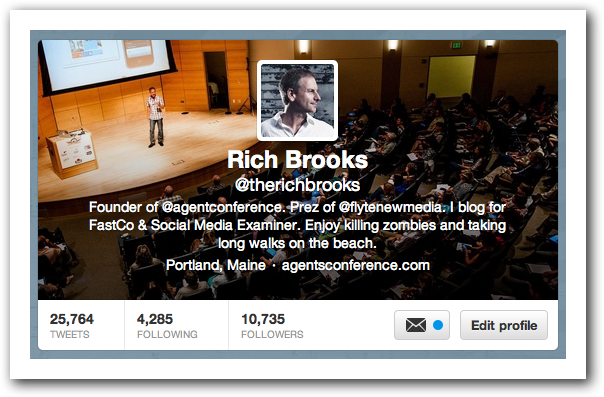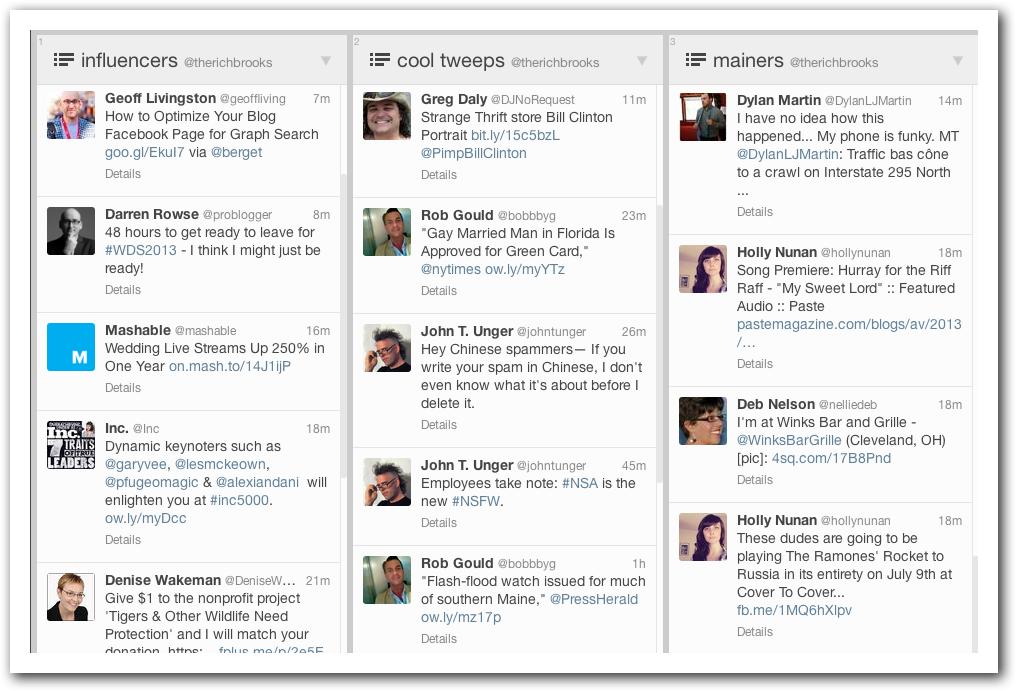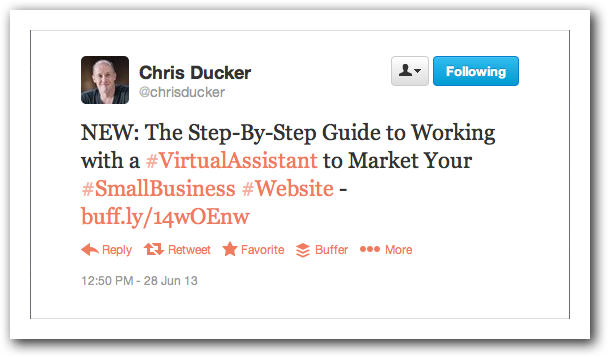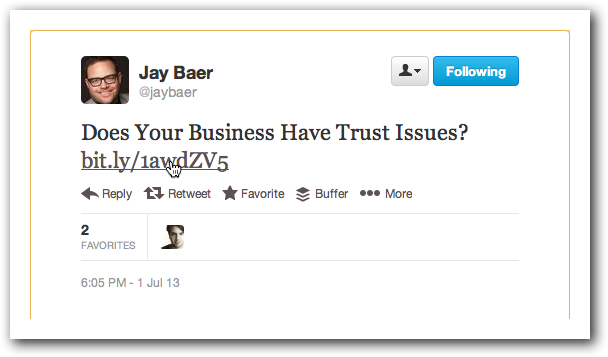Recently, a friend of mine joined Twitter. I immediately became her second, third and fourth follower, through a few different accounts I run. (See, it pays to be nice to me.)
She’s a pretty cool cat, but I realized she’s got a long way to go to build any type of following that will help propel her company or personal brand.
With that in mind, I decided to put together a framework for how you can quickly build a valuable following on Twitter, even when you’re starting from scratch.
Jen, this one’s for you. 😉
Establish your profile.
Before you start following anyone or even tweeting, you should establish an attractive, engaging profile. Your profile is made up of the following:
- Twitter Handle: Your handle can be up to 15 characters, must be unique, and should represent your personal or company brand. Adding numbers to the end, i.e., @johndoe1979, can cheapen your brand and makes you look like an also ran. Alternatively, adding “the” to your handle makes you look cool, suave and sophisticated, i.e., @therichbrooks.
- Name: Your name can be up to 20 characters and doesn’t have to be unique. So if you are John Doe, you’re in luck.
- Photo: Square, but you shouldn’t be. I’m a fan of closely cropped, smiling headshots for people, logos for brands. At 81 pixels wide, anything else is rendered unrecognizable.
- Bio: 160 characters to tell the world who you are…or just tease out enough information to make them interested. It can include URLs and/or other Twitter handles you want to promote.
- Link: Tell ‘em where you want them to go…a website, blog, or squeeze page, for example.
- Header image: At 520 x 260, the header image appears in your bio, regardless if someone is checking you out on a desktop, tablet or smartphone. Use it to share a little of who you are.
- Background image: There are no size limitations, and it does provide another opportunity for branding.

In addition, you should tweet out 5 – 10 times minimum before trying to attract followers or even following anyone yourself.
When you follow someone, Twitter gives them a heads up–often by email–that they have a new follower. If they click on the link to your profile and you haven’t said anything, you’re not giving them much reason to follow you.
On the other hand, if you have an engaging profile and some interesting, valuable tweets, you’ll greatly increase your chances of getting a “follow back.”
Follow The Right People
There are three types of accounts to follow on Twitter:
- Accounts you want to learn from: These are the news sources, influencers and industry leaders who may not follow you back, but provide such value and insight it’s worth following them anyway.
- Accounts to you want to follow you: Let’s face it: the reason many of us are on Twitter is to build a following. Following someone creates a feeling of reciprocity…they may feel a slight obligation to follow you back.
- Accounts you want to engage: Networking is a natural outcome of being active on Twitter. Like Soylent Green, Twitter is made of people.
To find the right people to follow, start with people you know in real life. Twitter offers a Find Friends tool that allows you to upload your email database (assuming you use a popular email program like Gmail or Yahoo mail) and find your connections that already are on Twitter.
You can then follow any or all of your contacts on Twitter, who will receive notice that you are now following them, and a link to your profile.
Beyond this initial group of friends and associates, you can use tools like WeFollow or Twellow to find prospects, thought leaders or like-minded people. You can also find great people to follow by searching and subscribing to other people’s Twitter lists.
Use Twitter Lists
In my opinion, Twitter lists are the most valuable, least utilized tool on all of Twitter. Lists are simply groups of accounts organized by you. They can be organized around an industry, geography, or made up entirely of people with mustaches.
You can create your own lists of up to 5,000 people, or subscribe to a list that someone else has created.
Creating and following lists are a great way to improve the signal to noise ratio on Twitter. Using a 3rd party app like TweetDeck or Hootsuite, you can create columns for your lists to improve your engagement and listening.

Here are just a few ways you could use Twitter lists for your business:
- Local: If your business is “geographically challenged,” do a Twitter search to find people within a 15 mile radius of your home town and add them to a list of local contacts. This way you can keep tabs on what’s going on locally.
- Influencers: Find some of the most influential people in your industry with a Twitter account and start following them.
- Prospects: If you can identify the audience you’re trying to reach, you can listen more actively to their conversations, and join in as appropriate.
- Media: If getting press is part of your marketing plan, it’s best to create a list of journalists who report on your industry. That way you can get a sense of what they’re talking about on social media, and you’ll have another avenue to engage them for potential stories.
Tweet Early and Often
Well, at least often. While a few people may unfollow you if you tweet too much, generally the more you tweet, the more followers you attract. Just always strive to provide value in your tweets.
Talk With People, Not At Them
When I see that someone’s Twitter feed is nothing but links to their blog or their activity on Facebook, or they’re always promoting but not engaging, I’m unlikely to follow them.
If you have five minutes between meetings, jump onto Twitter and see if you can answer someone else’s tweet, or pose a question of your own.
If you don’t have something to add to a tweet you like, consider retweeting or favoriting that tweet…both will be reported back to the original tweeter, increasing your visibility to them. Retweeting is the act of sharing someone else’s tweet (with citation) to your audience. Favoriting is the equivalent of “liking” or even bookmarking a tweet.
Use Hashtags
Now that Facebook has adopted hashtags, they won’t seem as foreign to new Twitter users.
Twitter users created hashtags to organize tweets. People now use them for a variety of reasons, from talking about a specific topic (#oscars, #bostonstrong, #smallbiz, etc.) Those hashtags become links so you can follow the conversation more easily.
Following and using hashtags in your tweets can help you find interesting conversations, and generate more meaningful followers.

Share Links
Twitter is a great tool for driving traffic. Tweets with links in them often get retweeted, shared and favorited, increasing your visibility and likely your followers.
It doesn’t have to be your content you’re sharing, either. In fact, people are probably more likely to share your tweets if they’re not self-promotional.
Many people have built up sizable followings just by becoming a curator: sharing great content from others. We follow these curators because they help us cut through the data smog to get to the content we value the most.

Takeaways
Starting a brand new Twitter account can feel like a daunting task. But if you setup an engaging profile, follow friends, associates and influencers, use Twitter lists and tweet valuable content regularly, you’ll build a following that matters.
